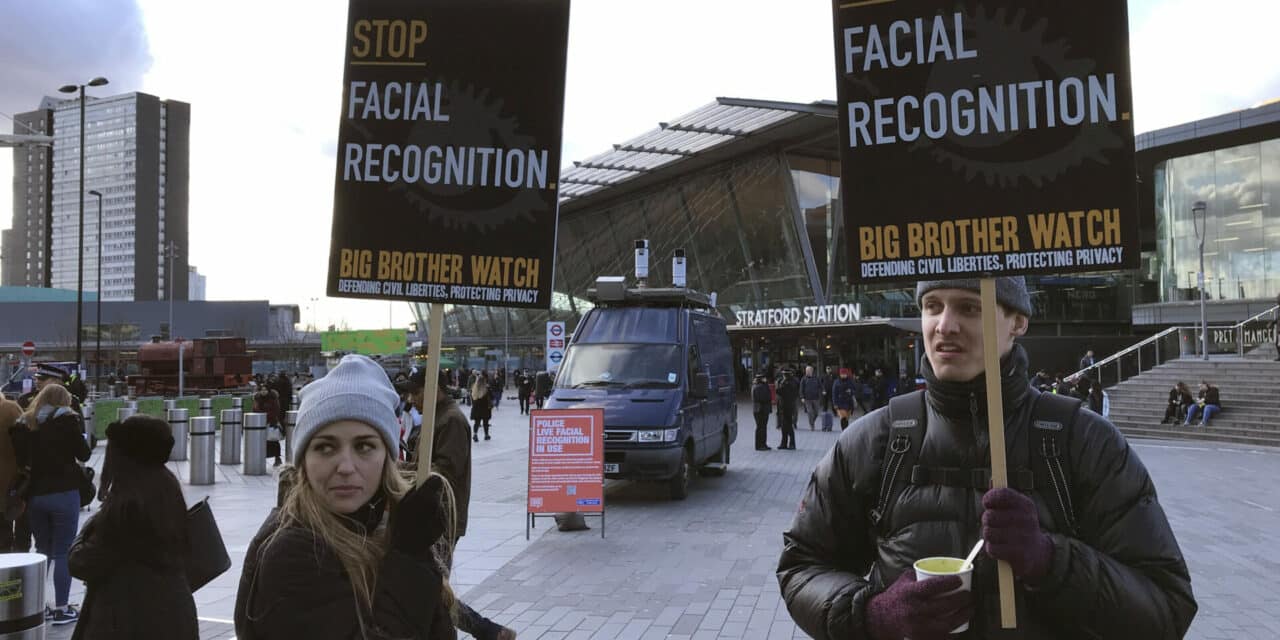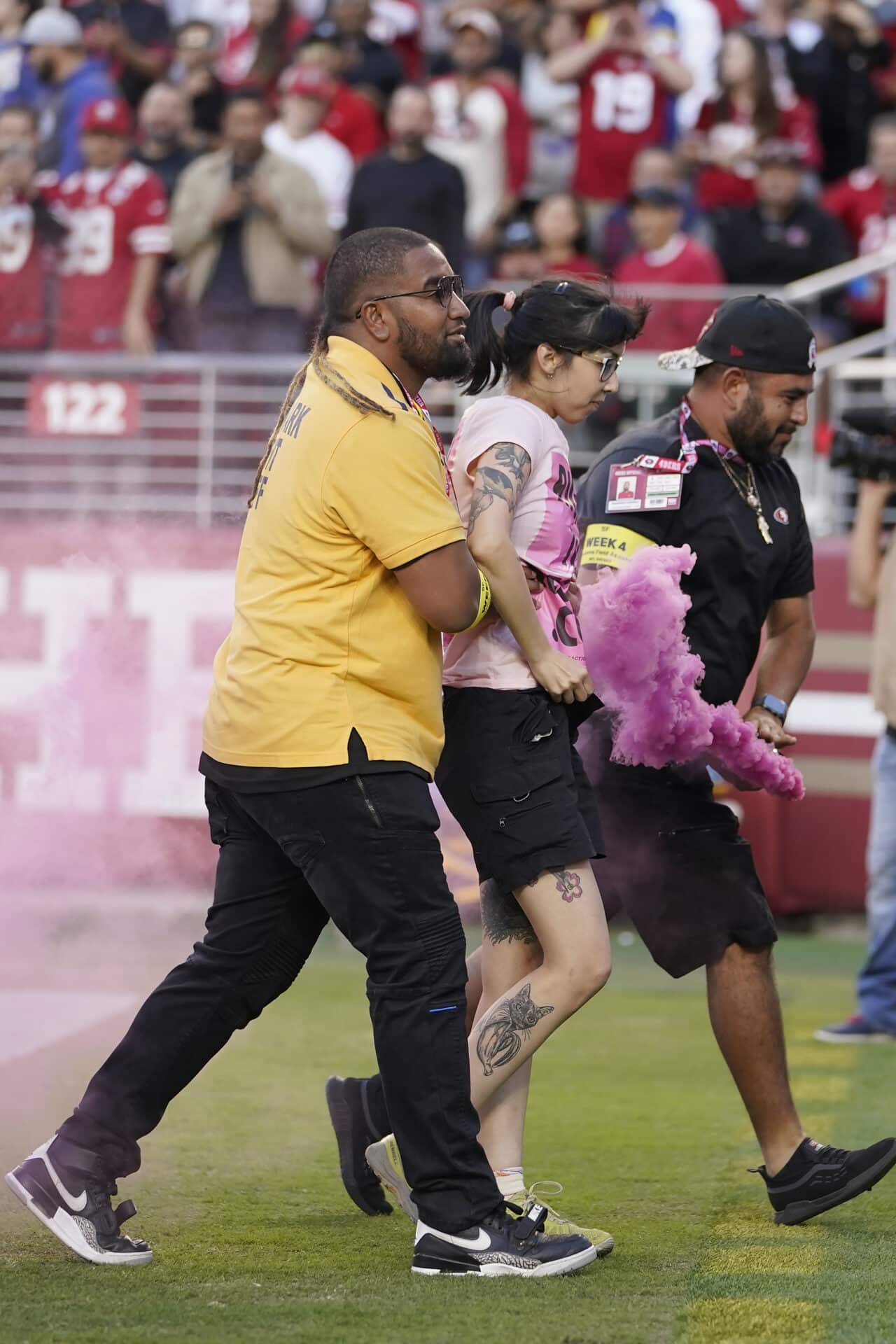
Service With A Smile: Security personnel escort a fan off the field during a San Francisco 49ers game at Levi’s Stadium on Oct. 3, 2022.
(This article first appeared in the March issue of VenuesNow)
The term “security” means different things to different people, and trends and priorities morph along with the times. But when it comes to large events, some core security elements remain constant.
“The fundamentals never change,” said Ty Richmond, president at Allied Universal, whose Event Services division provides security staffing and security for venues, events and corporate clients across the U.S. “You’re only as successful as you’re able to recruit and hire people, train them adequately and supervise and manage them.”
Recruitment and hiring have become difficult since COVID, however, with labor shortages and rising costs leading to staff scarcity. With event staff being often a guest’s primary contact at a venue, finding the right people is critical to ensuring not only a safe environment but a positive experience for guests.
“Staffing is the biggest challenge, as you probably see every day in any services industry,” added Richmond. “We’re competing with everyone else to try to hire. Most are part-time employees in the event services industry, so it’s about connecting the dots with the right kind of profile, the right skill set, the right kind of personality. That’s just been compounded now that you have a completely different workforce out there across the country.”
That’s the consensus among those who operate in the sector.
“The industry in general is very driven by staffing,” said Jeff Spoerndle, vice president at Best Crowd Management, a division of GardaWorld Security. “It’s much more expensive to operate in the space than it used to be. It costs more to source, recruit, process and background check people than it did even three years ago. The No. 1 thing you hear from customers as we’re going in is generally that their (security) provider can’t find staffing.”
Spoerndle, whose company recently handled security for the Pro Bowl in Las Vegas and Super Bowl Experience events at the Phoenix Convention Center, said current labor conditions mean not only making staff a priority but giving them the resources and opportunity to stay on board.
“We work hard with our retention techniques to retain the staff whereas maybe this industry in the past took the opinion that these are gigs that you weren’t going to have problems finding people for,” said Spoerndle, who says Best has grown in the last 18 months by 50%, largely because of its ability to provide adequate staffing. “That’s just not the case anymore. The difference maker anymore is all about staffing, the quality of people and how they’re trained.”
How they’re trained means more than tabletop exercises, too.
“It’s really important in today’s times to provide just an absolutely excellent experience for the guest,” he said.
While the core functions of preventing bad things from happening at events do not change, what entails an unsafe environment was thrown for a loop during COVID-19, with venues scrambling to adhere to changing medical guidelines and operate in a manner that was safe and legal while navigating an unprecedented global pandemic.
“Coming out of the pandemic there was definitely a difference in crowd behavior, and maybe more of a focus on health and sanitization issues,” said Mike Downing of Prevent Advisors, which is owned by VenuesNow parent company Oak View Group. “Now, we’re kind of balancing things out a little and giving security its fair due. We’re really trying to build this prevention culture, where even if security is not your No. 1 main priority, it is a priority and everybody has a responsibility in some way to develop a prevention culture so we’re not so reliant on the first responders and we prevent crisis before it comes.”
Technology is going a long way to help manage crowds and increase efficiency in screening, including sophisticated surveillance cameras.
“Some of these new camera systems, eight cameras can do the work that five years ago you needed 150 to do,” said Jim Hayes, vice president of sports and entertainment for Guidepost Solutions, which among its services develops security design for sports venues. “It’s just amazing to see how much better the technology is and how much more you can do with less.”
Contactless screening is a rapidly changing space, with fans and event managers praising the results and fans able to move quickly through checkpoints.
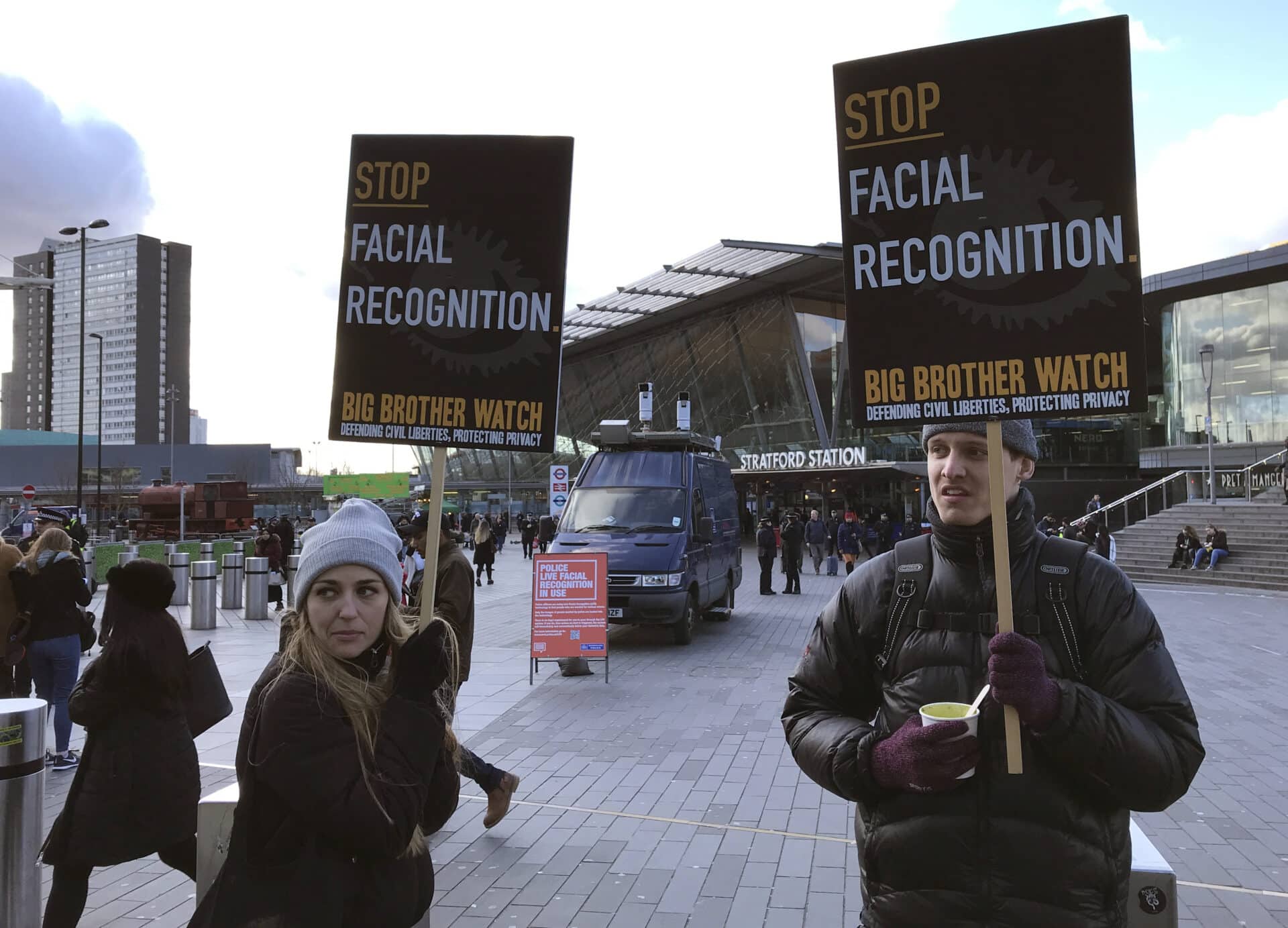
Big Brother Backlash: The increasingly high-tech security industry is navigating the public’s appetite for privacy concerns. (Getty Images).
“The new technology allows them to determine whether or not someone has a coin or a weapon in their pocket, and so you can set it for a particular sensitivity and know that it’s going to be accurate,” Hayes said.
Spoerndle adds, “Technologies like Open Gate and Evolve, for example, where guests can walk through at a real-time pace and they can detect a weapon, really speeds up the process. That ultimately keeps the flow going at entry points. The last thing you want is a big pool of people standing outside your metal detection checkpoint because that’s, in essence, a dirty zone where nobody has been screened and it leaves you vulnerable.”
Mark Camillo, Contemporary Services Corporation senior policy advisor, says new technologies are helping venues protect their guests and themselves from becoming a target.
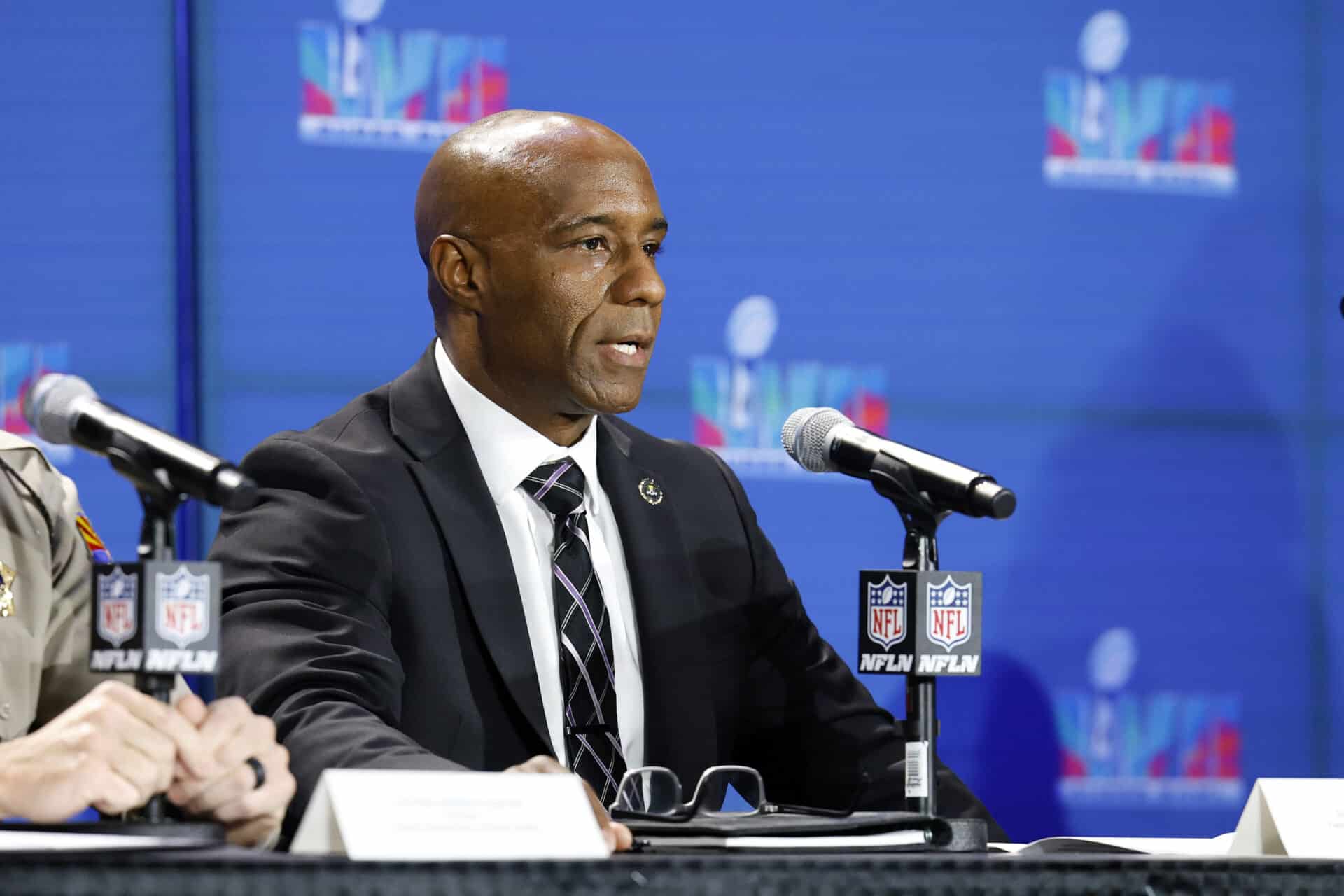
First Down: FBI Special Agent Akil Davis speaks during the Super Bowl public safety press conference in Phoenix on Feb. 7. The game is one of the few sporting events designated as national special security events by the Department of Homeland Security, requiring coordination from multiple law enforcement and security entities. (AP Images for the NFL)
Akil Davis, Special Agent In Charge, FBI Field Office, Phoenix speaks during the Super Bowl Public Safety Press Conference on Tuesday, Feb. 7, 2023, in Phoenix. (Gregory Payan/AP Images for NFL)
“The physical security to ensure that harmful things and harmful people are kept out of our events continues to evolve, or maybe a better word is to advance, and there are emerging technologies that are starting to be embraced by the industry,” Camillo said from Arizona ahead of Super Bowl LVII. The company handled staffing and event security for the Big Game, after running security at SoFi Stadium for last year’s Super Bowl.
“At the same time, they’re searching for ways to protect themselves, such as seeking a federal SAFETY act designation or certification that, in an unregulated industry such as public assembly facilities across the U.S., is one credential that is tough to get. But I think those that have gone through the process would agree that they are better off than they were before at their ability to detect and prevent bad things from happening.”
In a world dominated by smartphones and social media, facial recognition technology has made headlines as venues and cities look for enhanced security. The general public’s mood and overall sentiment may ebb and flow over time, but so can the technology.
“There’s a good debate over facial recognition, but there are technologies out there that can allow you to assess crowd movement and efficiency without actually taking full pictures of the face, and there are multiple ways to do that,” Hayes said. “If venues or certain municipalities are concerned about the legal issues associated with facial recognition, there’s also technologies that count bodies, count the pace they’re moving, where they’re at, seeing what the trends are in terms of how people move throughout a venue and what they want out of the experience. There’s multiple opportunities and options to do that to enhance safety no matter your legal appetite.”
Prevention is the name of the game, with the goal to create an environment less conducive to hostile or dangerous situations. However, some feel the focus on prevention has led to lax training for emergency situations.
“I think, instinctively, most entities do not prepare well enough to be able to react to an incident,” Allied’s Richmond said. “How you ensure and sustain an event is critical. When you’re involved in emotional services to people — and typically sports and entertainment and concerts are emotional things — you have to be able to close it out effectively, and people need to be able to leave and get home safely. That takes a lot of work and a lot of effort, a lot of attention to detail.”
The current landscape, while challenging in many aspects, does at least make security a priority, which the industry applauds.
“A positive that we have seen is that after events like AstroWorld and the Hollywood Bowl (where Dave Chappelle was charged by a fan) and incidents in general across the country, there’s a larger recognition and acknowledgment of the importance of the asset protection business and protecting human and physical assets,” Richmond said. “We’re seeing a much more thoughtful discussion around not only how do you hire, recruit, train and supervise, but the whole security apparatus is being taken even more seriously and being built into the business model much more effectively and more directly than it has been.”
Surveillance Goes High Tech With Hanwha Vision America Data, Analytics
As the event security industry contends with rising costs and a scarce labor pool, the tech side continues to provide solutions. New technology often provides the opportunity to gain efficiency, lowering cost as products improve, and in many cases reduce the amount of human labor required.
The surveillance industry is a prime example.
“Historically, bowl (video) coverage at stadiums has not been a major priority, which has surprised me quite a bit,” says Hanwha Vision America’s business development manager for arenas and stadiums, Mandi King. However, in recent years, sports leagues have begun requiring a certain level of security camera coverage within the seating bowl, down to the minimum pixels per foot and per seat. Advances in technology and camera production have made this much more efficient.
“We have an ultra high-res camera, it’s 8K in resolution and it can significantly cut down on the amount of cameras required to get that entire bowl coverage,” King adds. “There’s a few stadiums that were built within the last seven years before this technology was out, but now have upwards of 100 cameras or more to cover every seat in the house.”
While that may sound unwieldy or aesthetically unpleasing, the implications don’t end there.
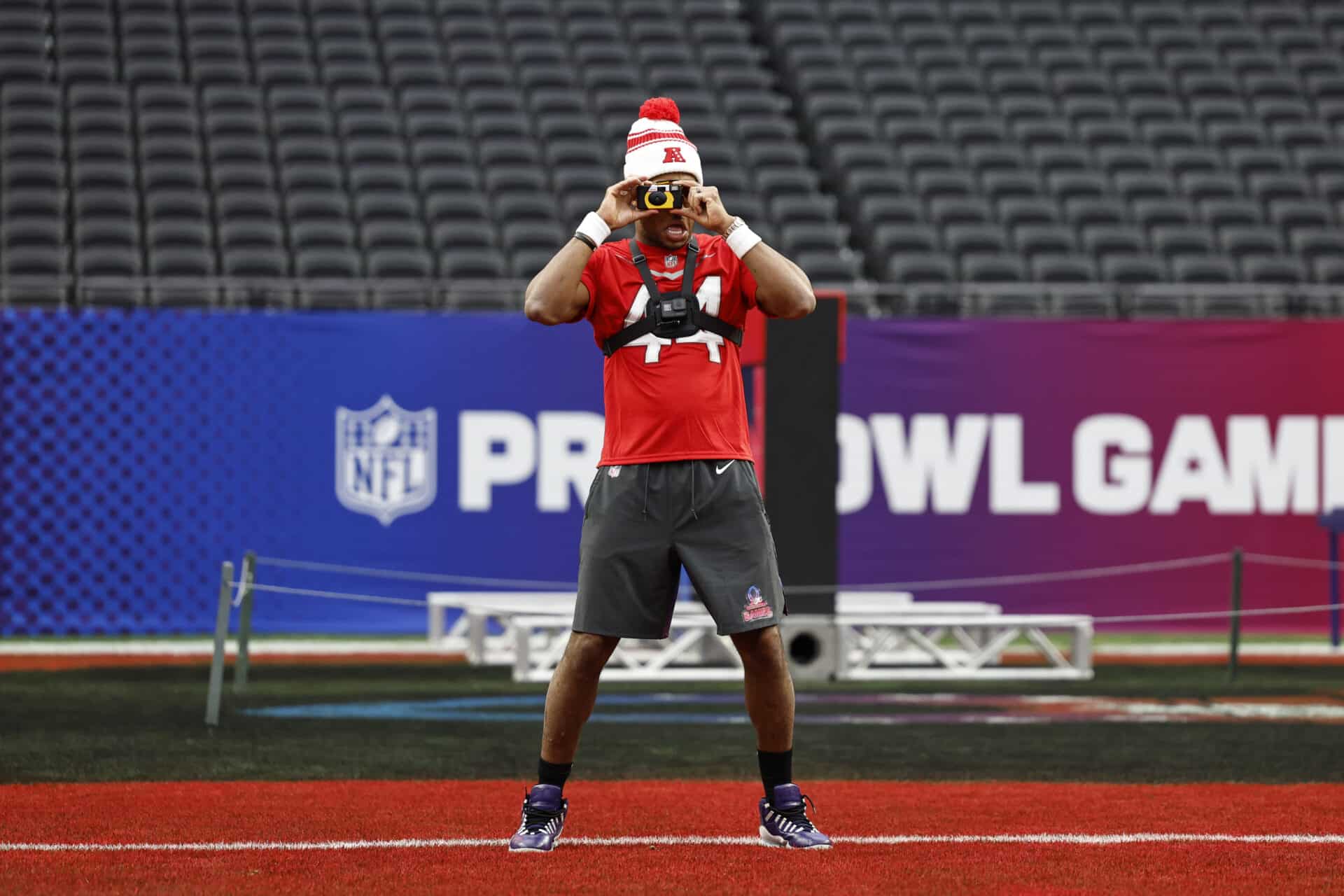
Eyes On The Prize: This year’s Pro Bowl took place Feb. 4 at Allegiant Stadium in Las Vegas, which is a client of Hanwha Vision America’s surveillance system. (Getty Images)
“The infrastructure required goes up as far as bandwidth requirements on your network and the cost associated with that — running cables to over 100 cameras, the licensing and storage requirements and things like that,” says King. “We learned to develop this camera from these end users, from major league stadiums, from the designers who put it together. We have taken that information and have been able to upgrade the cameras that we do have and also put new things on our roadmap to get these customers what they need at a price point and ease of use that they would prefer.”
Hanwha Vision America is primarily a security camera manufacturer, installing permanent surveillance fixtures at venues and sites including Churchill Downs and AT&T Stadium, providing security camera coverage throughout the facilities from loading docks to suites to backstage. With surveillance increasingly seen as a way of preventing incidents rather than going back to see what happened, cameras are now being used to track fan behavior and movement, which can aid marketing and operations at a venue.
“We have things like loitering detection that we could put in areas, it could be in employee-only areas, for instance,” King says. “Also we have attribute extraction analytics as part of our suite on some of our cameras that can provide color of clothing, can guess at someone’s gender and things like that. You’re able to export that data, you can get a feel for where away fans are visiting in your facility, where your home fans are visiting in your facility based on those attribute extractions, where to place advertisements and things like that.”
Monitoring crowd behavior through these edge analytics can help determine what kind of security plan makes sense for events.
“Being able to tell who is in a certain area and where incidents are occurring, they have been able to determine how many security people they need on staff during those times because of the data that has come from analytics,” King said. “A Beach Boys concert may not need as many security people as a Bad Bunny concert. However, we were told that some knitting needles were tried to sneak into a Beach Boys concert pretty recently, which was funny.”
Hanwha Vision America, until recently known as Hanwha Techwin, is a division of Hanwha Group, a $60 billion Fortune 500 South Korean conglomerate. The Hanwha Vision America team touts the division’s control of its own supply chain, which means it can produce and deliver products quickly. That means any delay would take weeks rather than months, according to Jordan Rivchun, director of vertical business development.
The cameras also work easily with existing software and security management platforms.
“We are not proprietary, so our cameras speak a common language,” Rivchun said. “They’re integrated with some of the common video management platforms and systems that are out there. So the cameras can pretty much plug and play into any platform or system depending on what the customers are talking about.”
The ability to be nimble on the supply side means crafting specific solutions in real time.
“Our team is laser-focused on not just selling this vertical, but really building a strong emotional connection to the customer base so we can actually respond with products that fit their needs,” he said. “We heard, ‘Hey, maybe this form factor is too large, we need something smaller.’ Mandi’s team can collaboratively and in the moment get that feedback and start designing a product or a solution that fits the bill.”
